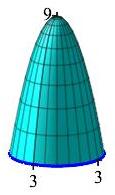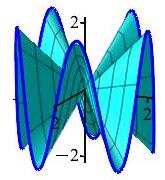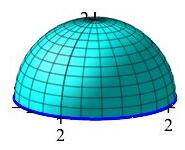26. Stokes' Theorem
Let \(S\) be a nice surface in \(\mathbb{R}^3\) with a nice properly oriented boundary, \(\partial S\), and let \(\vec{F}\) be a nice vector field on \(S\). Then \[ \iint_S \vec{\nabla}\times\vec{F}\cdot d\vec{S} =\oint_{\partial S} \vec{F}\cdot d\vec{s} \] Each piece of the boundary of the surface must be traversed counterclockwise as seen from the tip of the normal vector to the surface.
d. Applications
2. Converting Surface Integrals to Line Integrals
Stokes' Theorem is used to convert a surface integral into a line integral when the boundary curve is simpler than the surface and/or the vector field is simpler than its curl or just simpler on the boundary. These problems are discussed here. (Applications which go in the other direction are discussed on the previous page).
Use Stokes' Theorem to compute \(\displaystyle \iint_S \vec{\nabla}\times\vec{F}\cdot d\vec{S}\) for \(\vec{F} =\left\langle-y+ze^{x^2+y^2},x+ze^{-x^2-y^2},z+x^2+y^2\right\rangle\) over the paraboloid \(P\) given by \(z=9-x^2-y^2\) for \(z \ge 0\) oriented out and up The paraboloid may be parametrized by \(\vec{R}(r,\theta) =(r\cos\theta,r\sin\theta,9-r^2)\).

Clearly the curl of \(\vec{F}\) is ugly, but the boundary curve, which is the
circle \(x^2+y^2=9\) for \(z=0\), is simple. Further, on the circle the
vector field reduces to
\[
\vec{F}=\langle-y,x,x^2+y^2\rangle
\]
which is also simple. So we want to use Stokes' Theorem and compute the line
integral \(\displaystyle \oint_{\partial S} \vec{F}\cdot d\vec{s}\).
We first parametrize the circle as:
\[
\vec{r}(\theta)=\vec R(3,\theta)
=(3\cos\theta,3\sin\theta,0)
\quad \text{for} \quad 0 \le \theta \le 2\pi
\]
We compute the tangent vector:
\[
\vec{v}=\langle-3\sin\theta,3\cos\theta,0\rangle
\]
Since the surface is oriented out and up, the curve must be oriented
counterclockwise which it is. On the circle the vector field is
\[
\vec{F}=\langle-y,x,x^2+y^2\rangle
=\langle-3\sin\theta,3\cos\theta,9\rangle
\]
So the integral is
\[
\iint_S \vec{\nabla}\times\vec{F}\cdot d\vec{S}
=\oint_{\partial S} \vec{F}\cdot d\vec{s}
=\int_0^{2\pi} \vec{F}\cdot\vec{v}\,d\theta
=\int_0^{2\pi} 9\,d\theta=18\pi
\]
Use Stokes' Theorem to compute \(\displaystyle \iint_S \vec{\nabla}\times\vec{F}\cdot d\vec{S}\) for \(\vec{F}=\langle-y,x,x^2+y^2\rangle\) over the oscillating surface \(S\) shown at the right oriented upward, which may be parametrized by \(\vec{R}(r,\theta) =\langle r\cos\theta,r\sin\theta,r\sin(5\theta)\rangle\) for \(r\le2\).

The boundary curve may be obtained by setting \(r=2\) in the surface \(\vec{R}(r,\theta)\). So: \[ \vec r(\theta)=\vec{R}(2,\theta) =\langle 2\cos\theta,2\sin\theta,2\sin(5\theta)\rangle \] Notice how \(x\) and \(y\) go around a circle while \(z\) oscillates up and down \(5\) times.
\(\displaystyle \oint_{\partial S} \vec{F}\cdot d\vec{s}=8\pi\)
Since we are told to use Stokes' Theorem, we convert the integral into the line integral \(\displaystyle \oint_{\partial S} \vec{F}\cdot d\vec{s}\) around the boundary. The boundary curve may be obtained by setting \(r=2\) in the surface \(\vec{R}(r,\theta)\). So: \[ \vec r(\theta)=\vec{R}(2,\theta) =\langle 2\cos\theta,2\sin\theta,2\sin(5\theta)\rangle \] The velocity is: \[ \vec v=\langle -2\sin\theta,2\cos\theta,10\cos(5\theta)\rangle \] Since the surface is oriented upward, the boundary must be traversed counterclockwise, which is the direction \(\vec v\) points. On the curve, the vector field becomes: \[ \vec{F}=\langle-y,x,x^2+y^2\rangle =\langle-2\sin\theta,2\cos\theta,4\rangle \] So their dot product is: \[ \vec{F}\cdot\vec v =4\sin^2\theta+4\cos^2\theta+40\cos(5\theta) =4+40\cos(5\theta) \] So the line integral is: \[ \oint_{\partial S} \vec{F}\cdot d\vec{s} =\int_0^{2\pi} [4+40\cos(5\theta)]\,d\theta =\left[\rule{0pt}{10pt}4\theta+8\sin(5\theta)\right]_0^{2\pi} =8\pi \]
Notice that by doing the line integral instead of the surface integral, we did not need to compute the curl of \(\vec F\), nor the normal vector to the surface, nor do a double integral instead of a single integral.
Which Surface Integrals Can be Done Using Stokes' Theorem?
Suppose you are asked to compute \(\displaystyle \iint_S \vec F\cdot d\vec{S}\). Can you always use Stokes' Theorem to do this? No! If \(\vec F\) has a vector potential, \(\vec A\), then \(\vec F=\vec\nabla\times\vec A\) and by Stokes' Theorem: \[ \iint_S \vec F\cdot d\vec{S} =\iint_S \vec\nabla\times\vec A\cdot d\vec{S} =\oint_{\partial S} \vec A\cdot d\vec{s} \] However, if \(\vec F\) does not have a vector potential, then you can not use Stokes' Theorem and you must do the integral directly as: \[ \iint_S \vec F\cdot d\vec{S} =\iint_S \vec{F}(\vec R(u,v))\cdot\vec N\,du\,dv \] See the basic definition of the surface integral of a vector. You can check to see if \(\vec F\) has a vector potential, by computing its divergence. If \(\vec\nabla\cdot\vec F\ne0\) then \(\vec F\) does not have a vector potential. If \(\vec\nabla\cdot\vec F=0\) then \(\vec F\) probably has a vector potential and definitely does if \(\vec F\) is continuous on all of \(\mathbb R^3\).
Compute the surface integral \(\displaystyle \iint_H \vec{F}\cdot d\vec{S}\) for \(\vec{F}=\langle 2yz,2xz,2xy\rangle\) over the hemisphere \(H\) given by \(z=\sqrt{4-x^2-y^2}\) oriented upward.

Compute \(\vec\nabla\cdot\vec F\).
\(\displaystyle \iint_H \vec{F}\cdot d\vec{S} =\oint_{\partial H} \vec A\cdot d\vec{s} =0\)
To see if \(\vec F=\langle 2yz,2xz,2xy\rangle\) has a vector potential, we compute \(\vec\nabla\cdot\vec F=0+0+0=0\). So \(\vec F\) has a vector potential. We write \(\vec F=\vec\nabla\times\vec A\) and assume \(A_3=0\). So we need to solve \[\begin{aligned} -\partial_z A_2&=F_1=2yz \\ \partial_z A_1&=F_2=2xz \\ \partial_x A_2-\partial_y A_1&=F_3=2xy \\ \end{aligned}\] The first two equations say \(A_2=-yz^2+f(x,y)\) and \(A_1=xz^2+g(x,y)\). Then the third equation says \(\partial_xf-\partial_yg=2xy\). This is satisfied by \(f=x^2y\) and \(g=0\). So \[ \vec A=\langle xz^2,-yz^2+x^2y,0\rangle \] So \[ \iint_H \vec{F}\cdot d\vec{S} =\iint_H \vec\nabla\times\vec A\cdot d\vec{S} =\oint_{\partial H} \vec A\cdot d\vec{s} \] The boundary is the circle \(x^2+y^2=4\) with \(z=0\) traversed counterclockwise. It may be parametrized by \(\vec r=(2\cos\theta,2\sin\theta,0)\) and has velocity \(\vec v=\langle-2\sin\theta,2\cos\theta,0\rangle\). On the curve the vector field is \(\vec A=\langle 0,4\cos^2\theta2\sin\theta,0\rangle\) and its dot product with the velocity is \(\vec A\cdot\vec v=0+4\cos^2\theta2\sin\theta2\cos\theta+0 =16\cos^3\theta\sin\theta\). So the integral is \[ \oint_{\partial H} \vec A\cdot d\vec{s} =\int_0^{2\pi} 16\cos^3\theta\sin\theta\,d\theta =\left[\rule{0pt}{10pt}-4\cos^4\theta\right]_0^{2\pi}=0 \]
Compute the surface integral \(\displaystyle \iint_H \vec{F}\cdot d\vec{S}\) for \(\vec{F}=\langle 2xz,2yz,2z^2\rangle\) over the hemisphere \(H\) given by \(z=\sqrt{4-x^2-y^2}\) oriented upward.

Compute \(\vec\nabla\cdot\vec F\).
\(\displaystyle \iint_H \vec{F}\cdot d\vec{S} =32\pi\)
To see if \(\vec F=\langle 2xz,2yz,2z^2\rangle\) has a vector potential, we compute \(\vec\nabla\cdot\vec F=2z+2z+4z\ne0\). Since the divergence is non-zero, \(\vec F\) does not have a vector potential and we need to compute the surface integral directly. The hemisphere may be parametrized in spherical coordinates as: \[ \vec R(\phi,\theta)=\langle2\sin\phi\cos\theta,2\sin\phi\sin\theta,2\cos\phi\rangle \] for \(0\le\phi\le\pi\) and \(0\le\theta\le2\pi\). The normal is: \[\begin{aligned} \vec{N}&=\vec{e}_\phi\times\vec{e}_\theta =\begin{vmatrix} \hat{\imath} & \hat{\jmath} & \hat{k} \\ (2\cos\phi\cos\theta&2\cos\phi\sin\theta&-2\sin\phi) \\ (-2\sin\phi\sin\theta&2\sin\phi\cos\theta&\quad0\quad) \end{vmatrix} \\ &=\langle4\sin^2\phi\cos\theta,4\sin^2\phi\sin\theta,4\sin\phi\cos\phi\rangle \end{aligned}\] Next, we evaluate \(\vec F=\langle 2xz,2yz,2z^2\rangle\) on the surface and compute its dot product with the normal: \[\begin{aligned} \vec F(\vec R(\phi,\theta)) &=\langle 8\sin\phi\cos\phi\cos\theta,8\sin\phi\cos\phi\sin\theta,8\cos^2\phi\rangle \\ \vec F\cdot\vec N &=32\sin^3\phi\cos\phi\cos^2\theta +32\sin^3\phi\cos\phi\sin^2\theta +32\cos^3\phi\sin\phi \\ &=32\sin^3\phi\cos\phi+32\sin\phi\cos^3\phi =32\sin\phi\cos\phi \end{aligned}\] So the integral is: \[\begin{aligned} \iint_H \vec{F}\cdot d\vec{S} &=\int_0^{2\pi}\int_0^{\pi/2} \vec{F}\cdot\vec N\,d\phi\,d\theta \\ &=\int_0^{2\pi}\int_0^{\pi/2} 32\sin\phi\cos\phi\,d\phi\,d\theta \\ &=64\pi\left[\dfrac{\sin^2\phi}{2}\right]_0^{\pi/2} =32\pi \end{aligned}\]
Heading
Placeholder text: Lorem ipsum Lorem ipsum Lorem ipsum Lorem ipsum Lorem ipsum Lorem ipsum Lorem ipsum Lorem ipsum Lorem ipsum Lorem ipsum Lorem ipsum Lorem ipsum Lorem ipsum Lorem ipsum Lorem ipsum Lorem ipsum Lorem ipsum Lorem ipsum Lorem ipsum Lorem ipsum Lorem ipsum Lorem ipsum Lorem ipsum Lorem ipsum Lorem ipsum